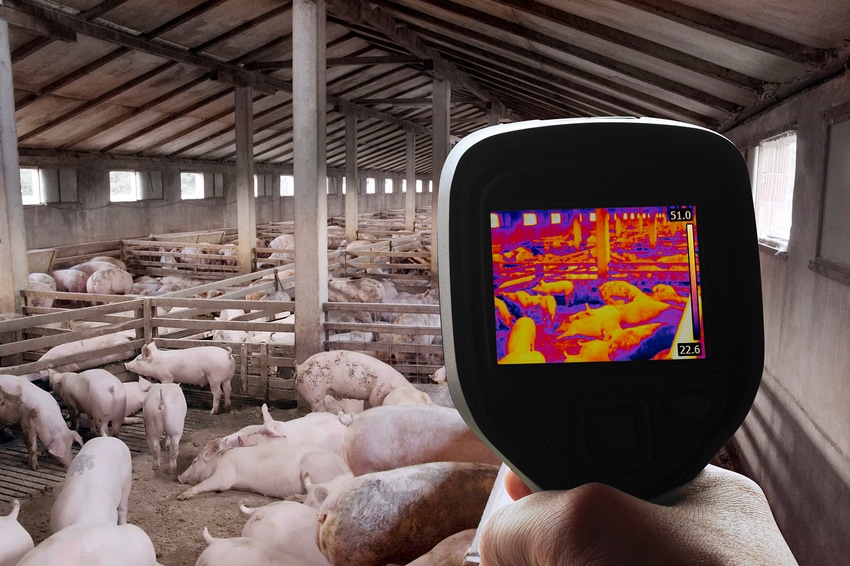To be effective, movement, audio and visual sensors technologies should be readily available, cost-effective and reliable.
May 2, 2019

By Jonathan Holt, PhD, North Carolina State University Extension Swine Specialist
Advances in technologies have started to make a mark in animal agriculture and the concept of precision livestock farming, one that caters to needs of the animal on an individual basis, is more realistic than ever. Sensors and other automated technologies have enabled academicians, farmers and allied industry alike with regards to continuous monitoring and collection of environmental, physiological and ethological data.
Fixed sensors are common to most everyone in the form of thermometers and cameras that can be used to capture heat and motion in a swine facility. Camera technology has been improving rapidly and with it, so has the ability to use image data to alert producers to pig health and productivity. Traditional 2D imaging has typically been used to monitor behavior of sows and pigs and has recently been studied in order to estimate pig weights. However, the advancement of 3D cameras, which adds a depth measure to the equation, has allowed more effective use of camera imaging. Coupled with infrared, 3D cameras are able to work in lower light settings and do not require contrasting backgrounds between subjects, making them more robust than 2D cameras. Infrared imaging is also being studied to determine its effectiveness in temperature monitoring of pigs. An infrared camera can check temperatures without making physical contact with the animal, therefore, it can be done remotely.
Another strategy being tested with camera imaging is the potential to use facial recognition to identify individual pigs, thus eliminating markers such as ear tags and tattoos. While still in early stages of research, some groups have reported up to 97% accuracy of identifying individual animals using this technique. The technology has been widely used in human applications and could be adopted quickly to swine production. A newer application of fixed sensor technology in swine production has been the use of microphones to collect audio data in a production facility. The goal of audio data is to determine specific events that predict changes in pig health or stress. A few examples available currently are audio sensors recording coughs to signal a respiratory illness and audio sensors in the farrowing crate to identify piglet squeals as potential stressful situations. If the ability to predict productivity and health from audio signals improves, expect vocalizations to become daily measures just like temperature.
While fixed sensors are fairly common in current swine facilities, wearable sensors are among the most promising technologies for monitoring swine behavior, health and productivity. One type of wearable sensor is known as an accelerometer, which is similar to a FitBit that people may use to track exercise. These sensors can track the individual movements of a pig and give us insight into feed and water intake, typical movement throughout the day, lack of movement (a signal of lameness), and do this all in real-time, which is why the technology is gaining so much interest. Radio frequency identification chips also have promise as wearable sensors because they have the ability to store large amounts of data about the individual. RFID technology has been routinely used in electronic sow feeders, however most of these utilize low-frequency RFID which have low read ranges and can only store data on one animal, major disadvantages when it comes to advanced data collection goals. Wearable sensors also have the drawback of potential loss of the device, stress to the animal when attaching the sensor and the removal of the device at slaughter.
To be effective, these movement, audio and visual sensors technologies should be readily available, cost-effective and reliable. However, the biggest challenge in utilizing sensor technology is the extraction of important conclusions from the huge data sets collected from a wide variety of sensors.
Realizing the importance of advancing the use of sensors technology in swine production, as well as other livestock species, North Carolina State University will be hosting the 1st International Symposium on Precision Systems and Data Analysis in Animal Agriculture in September. The symposium is in response to unmet, rising research and application needs of automation and big data analysis in managing animal health, welfare and production. This symposium will be unique, as it is intended to act as a collaborative nexus for professionals from different disciplines (animal science, engineering, mathematics and statistics, biology, and more) to share ideas and foster an open dialogue about the advancements and issues facing the use of technology in animal agriculture. The symposium will be open to researchers, technology companies, the allied animal agriculture industry, as well as producers. The venue will be structured to facilitate interaction and discussions among all these groups to further understand technology availability and needs both now and into the future. A few of the main topics to be addressed are: implantable and wearable sensors, data visioning and mining and opportunities and challenges training digital natives in animal agriculture.
The symposium will be soliciting abstracts for research focused on the main topics as well as a student poster competition. More information will be available soon. If you have questions or are interested in being a speaker or sponsor of the International Symposium on Precision Systems and Data Analysis in Animal Agriculture, contact me.
Source: Jonathan Holt of North Carolina State University, who is solely responsible for the information provided, and wholly owns the information. Informa Business Media and all its subsidiaries are not responsible for any of the content contained in this information asset.
You May Also Like



